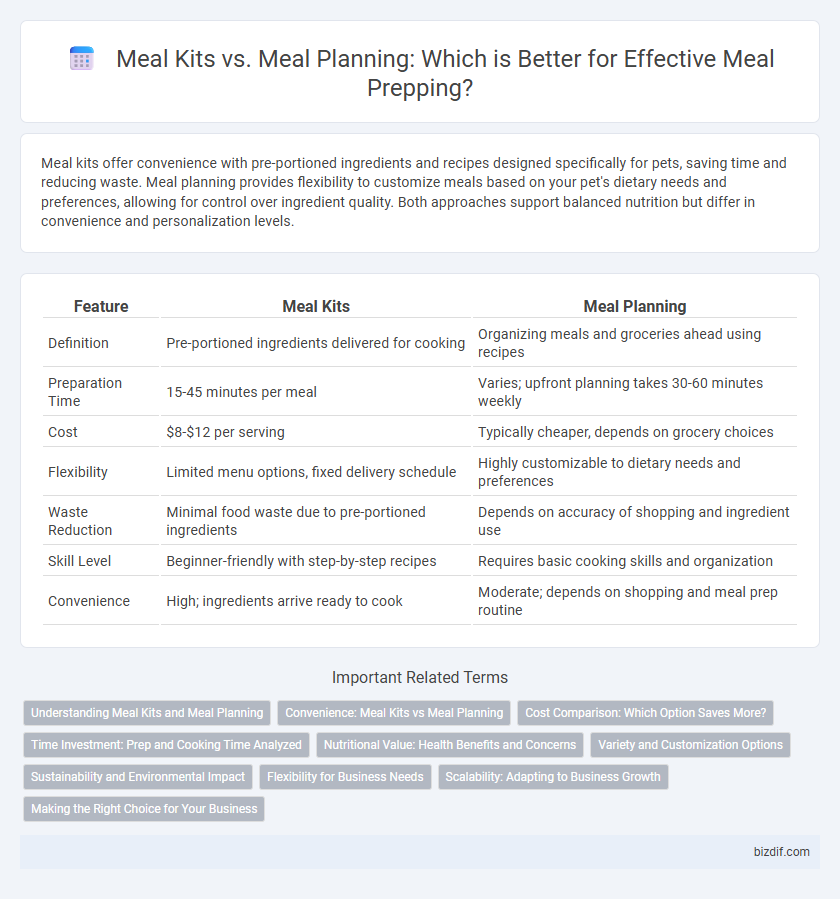Meal kits offer convenience with pre-portioned ingredients and recipes designed specifically for pets, saving time and reducing waste. Meal planning provides flexibility to customize meals based on your pet's dietary needs and preferences, allowing for control over ingredient quality. Both approaches support balanced nutrition but differ in convenience and personalization levels.
Table of Comparison
| Feature | Meal Kits | Meal Planning |
|---|---|---|
| Definition | Pre-portioned ingredients delivered for cooking | Organizing meals and groceries ahead using recipes |
| Preparation Time | 15-45 minutes per meal | Varies; upfront planning takes 30-60 minutes weekly |
| Cost | $8-$12 per serving | Typically cheaper, depends on grocery choices |
| Flexibility | Limited menu options, fixed delivery schedule | Highly customizable to dietary needs and preferences |
| Waste Reduction | Minimal food waste due to pre-portioned ingredients | Depends on accuracy of shopping and ingredient use |
| Skill Level | Beginner-friendly with step-by-step recipes | Requires basic cooking skills and organization |
| Convenience | High; ingredients arrive ready to cook | Moderate; depends on shopping and meal prep routine |
Understanding Meal Kits and Meal Planning
Meal kits provide pre-portioned ingredients and step-by-step recipes, simplifying cooking while saving time and reducing food waste. Meal planning involves designing weekly menus, shopping lists, and meal schedules to optimize nutrition, budget, and variety. Understanding both approaches helps tailor cooking habits to lifestyle needs, balancing convenience with customization and cost-efficiency.
Convenience: Meal Kits vs Meal Planning
Meal kits offer unmatched convenience by providing pre-portioned ingredients and step-by-step recipes, saving time on grocery shopping and meal preparation. Meal planning requires more effort upfront, including selecting recipes, shopping for diverse ingredients, and organizing cooking schedules. Consumers seeking quick, hassle-free cooking often prefer meal kits, while those aiming for budget control and dietary customization lean towards meal planning.
Cost Comparison: Which Option Saves More?
Meal kits typically have higher upfront costs due to pre-portioned ingredients and convenience fees, averaging $8 to $12 per serving. In contrast, traditional meal planning allows bulk purchasing and substantial use of pantry staples, reducing average meal costs to $4 to $6 per serving. Over time, meal planning offers significant savings, especially for larger households or those committed to batch cooking.
Time Investment: Prep and Cooking Time Analyzed
Meal kits significantly reduce time investment by providing pre-portioned ingredients and detailed recipes, cutting down both prep and cooking duration compared to traditional meal planning. Meal planning often requires substantial time for ingredient selection, grocery shopping, and portioning, extending overall preparation. Consumers prioritizing efficiency benefit from meal kits, which streamline the cooking process and minimize kitchen workload.
Nutritional Value: Health Benefits and Concerns
Meal kits provide pre-portioned ingredients designed for balanced nutrition, often including detailed calorie and macronutrient information that supports weight management and dietary goals. Meal planning, however, allows customization based on individual nutritional needs, enabling adjustments for allergies, specific diets like keto or vegan, and control over sodium, sugar, and fat intake. Health concerns arise with meal kits due to potential preservatives and less flexibility, whereas meal planning demands nutritional knowledge but offers greater control over food quality and nutrient density.
Variety and Customization Options
Meal kits offer diverse recipe options with pre-portioned ingredients, simplifying variety while limiting customization due to fixed meal selections. Meal planning provides greater flexibility to tailor meals to dietary preferences and nutritional goals, allowing for personalized ingredient choices and portion sizes. Combining both approaches can enhance variety and customization, balancing convenience with individual needs.
Sustainability and Environmental Impact
Meal kits often generate more packaging waste compared to traditional meal planning, which typically utilizes bulk ingredients and reusable containers, reducing overall environmental footprint. Meal planning encourages buying locally-sourced and seasonal produce, minimizing carbon emissions associated with transportation and storage. Opting for meal planning can significantly lower food waste by allowing precise portion control and ingredient usage, contributing to greater sustainability efforts.
Flexibility for Business Needs
Meal kits offer structured convenience with pre-portioned ingredients and recipes designed for quick assembly, ideal for businesses seeking consistent menu offerings and controlled inventory. Meal planning provides greater flexibility to customize meals based on available ingredients, dietary preferences, and evolving business demands, supporting diverse customer needs and adaptable menus. Balancing meal kits' efficiency with meal planning's adaptability can optimize operational flexibility and customer satisfaction in a dynamic food service environment.
Scalability: Adapting to Business Growth
Meal kits offer scalable solutions for business growth by streamlining ingredient sourcing, portion control, and packaging processes, enabling consistent quality and faster fulfillment as demand increases. Meal planning requires more dynamic adjustments and resource allocation, often involving personalized customization that can challenge scalability and operational efficiency. Investing in technology and standardized workflows enhances scalability in meal kit services compared to traditional meal planning approaches.
Making the Right Choice for Your Business
Choosing between meal kits and meal planning depends on your business goals, target market, and operational capacity. Meal kits offer convenience and portion-controlled ingredients that appeal to busy consumers seeking time-saving solutions, while meal planning services emphasize customization and long-term dietary management for health-conscious clients. Evaluating factors such as supply chain logistics, cost efficiency, and customer preferences is essential for making the right strategic decision to maximize profitability and client satisfaction.
Meal kits vs meal planning Infographic

 bizdif.com
bizdif.com